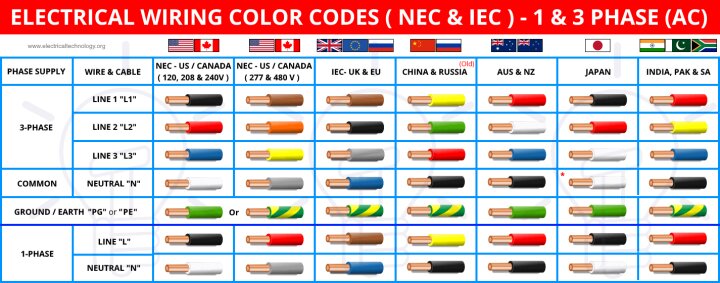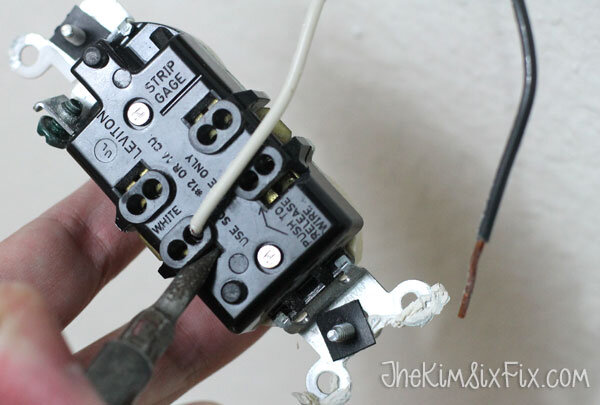Once again the USA gets right what the Euros/Brits get incredibly wrong
Here we have a chart of the several AC wiring color codes from around the word. Most notable the US/Canada NEC vs. the Euro IEC
If we look at the single phase column we see some variations. But for the most part there is a logical rythym for most of the planet.
Black for hot ( because if you touch your dead) in the USA. Red ( danger) in Canada. Japan too knows what's up. The rest of the world seems to follow suit more or less here not being totally brain dead. China goes with yellow, sorta odd but makes sense. It's colorful, colorful means lively. Alice with electrons. Yes.
But there's a small catch in this chart. It doesn't accurately detail split phase. So if we look at the 3 phase panel we see the second phase is marked red for the use and orange for Canada. So really a single phase wiring would be red or black for US or orange or red for Canada. We already mentioned the logical reasoning for red, orange makes sense to as being sorta red, red adjacent if you will.
Now let's get to the dumbassery.
If we look at the neutral column we see some true weirdness. The Turbo Graffix-16 has decided once again logically neutral should be white. White being well neutral in color. But look at the Brits and Euros.Blue...BLUE? Blue? Blue is anything but neutral it's very blue. Which is why the NEC harnessing the awesome power of 16 bit graphics has related it to the hot of the third phase of wiring.. Canada wanted to spice it up a bit which is fine and gone with grey, again grey being a very neutral tone.
We all agree green of some sort should be earth. Of course it should, the Earth is green.
Again we have the Euros and Brits and decide no. Brown is hot!. Brown what the hell is this lamp cord doing in the gange box? Is this some sort of Super Earth? Can't surely be a hot lead it's the color of dirt, it must be ground. But no fuck logic it's a hot lead.. Canada it's half corrected state goes full Tropic thunder in the three phase wiring and all of a sudden the first phase is brown. I pitty them for their British influence. Instead of just leaving the first phase red as it was in half phase.
The rest of the world just goes willy-nilly after this and it's best are off. Some even use black as the neutral which is again pure lunacy. But it pales in comparison to the absurdity of EU wiring making brown a hot lead and blue a neutral reference. No wonder they have such stupid and ridiculous outlet and curious breakers. Fucking lunatics. Big ups to Japan for choosing the circuit path of civility though.
If we look at the single phase column we see some variations. But for the most part there is a logical rythym for most of the planet.
Black for hot ( because if you touch your dead) in the USA. Red ( danger) in Canada. Japan too knows what's up. The rest of the world seems to follow suit more or less here not being totally brain dead. China goes with yellow, sorta odd but makes sense. It's colorful, colorful means lively. Alice with electrons. Yes.
But there's a small catch in this chart. It doesn't accurately detail split phase. So if we look at the 3 phase panel we see the second phase is marked red for the use and orange for Canada. So really a single phase wiring would be red or black for US or orange or red for Canada. We already mentioned the logical reasoning for red, orange makes sense to as being sorta red, red adjacent if you will.
Now let's get to the dumbassery.
If we look at the neutral column we see some true weirdness. The Turbo Graffix-16 has decided once again logically neutral should be white. White being well neutral in color. But look at the Brits and Euros.Blue...BLUE? Blue? Blue is anything but neutral it's very blue. Which is why the NEC harnessing the awesome power of 16 bit graphics has related it to the hot of the third phase of wiring.. Canada wanted to spice it up a bit which is fine and gone with grey, again grey being a very neutral tone.
We all agree green of some sort should be earth. Of course it should, the Earth is green.
Again we have the Euros and Brits and decide no. Brown is hot!. Brown what the hell is this lamp cord doing in the gange box? Is this some sort of Super Earth? Can't surely be a hot lead it's the color of dirt, it must be ground. But no fuck logic it's a hot lead.. Canada it's half corrected state goes full Tropic thunder in the three phase wiring and all of a sudden the first phase is brown. I pitty them for their British influence. Instead of just leaving the first phase red as it was in half phase.
The rest of the world just goes willy-nilly after this and it's best are off. Some even use black as the neutral which is again pure lunacy. But it pales in comparison to the absurdity of EU wiring making brown a hot lead and blue a neutral reference. No wonder they have such stupid and ridiculous outlet and curious breakers. Fucking lunatics. Big ups to Japan for choosing the circuit path of civility though.








